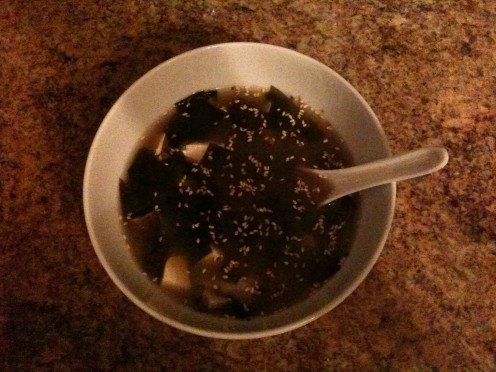How to Make Miso Soup
What is Miso Soup?
Whenever you go to a Japanese restaurant, and, even some Chinese ones, what you will always find in the menu is Miso soup. Miso soup is a Japanese soup that is made with dried seaweed, and Miso paste (made from soy). It is a delicious and refreshing soup that is served hot, but it is also good when it is warm or even chilled.
There are many ways to make Miso soup, and Japanese restaurants have their own variations. The ingredients that you are sure to find in Miso soup, in most restaurants, are: seaweed, scallion, tofu, and of course Miso paste (which is dissolved in water). The soup is not thick and doesn’t have a lot of ingredients so what you get served in a bowl is mostly the liquid. If you do not eat the soup right away, you will have to stir it before eating, as the miso paste will settle to the bottom of the bowl.
Whenever I go to a Japanese restaurant I always order Miso soup and I am such a huge fan of it that I even make it at home. The Miso soup that I make at home, however, I have yet to find served in a Japanese restaurant. I even prefer my Miso soup to theirs. I love substance in the soup not just liquid and a few pieces of seaweed and tofu.
Below, you will find my recipe for miso soup. Hope you enjoy it!
Miso Soup Recipe

Ingredients
- Seaweed (wakame - most widely used seaweed in Miso Soup, kelp, hijiki)
- Dried daikon radish
- Dried shitake mushrooms (sliced)
- Miso paste (red or white) - I prefer white
- Tofu
- Roasted sesame seeds
- Water
All these ingredients can be purchased in an Asian supermarket. If you do not have an Asian supermarket near you then head to your regular supermarket like ShopRite, Stop-n-Shop, etc. and see if it has these ingredients for sale. You can even try to find these ingredients online. Your best bet is Amazon and I have provided links to some of the ingredients for your convenience.
Cook Time
Instructions
- Take dried seaweed, dried daikon radish, and dried shitake mushrooms (sliced) and let them soak in water for about 10 minutes. (I usually place them into a pot I will make the soup in but you can use a bowl if you prefer.) - If any of the ingredients you are soaking are very big, you might want to cut them into smaller pieces so it will be easier to eat once the soup is done. Remember that the ingredients will get bigger in size when they are soaked in water so be sure to not use too much of each as the soup will be too thick.
- Once 10 minutes have passed move all the ingredients into a pot (if they are soaking in a bowl) along with the water. Add more water to the pot as needed. How much water and ingredients you add depends on how much soup you are planning to make and how you like your soup. For thicker soup add more ingredients.
- Now that all your ingredients are in the soup bowl and there is enough water, turn on the heat to medium and let the water come to a boil. Once the water starts boiling, let everything cook for about 25 minutes or so.
- While the soup is cooking, take out a big tablespoon of the Miso paste and put it in a small bowl. Then add a little bit of boiled warm water from the tea kettle and mix it so that the paste is even and not in clumps. As an alternative you can also just take the broth from the pot, place it in a bowl, and once it has cooled a little bit, stir in the Miso paste.
- After about 25 minutes have passed, stir in the dissolved Miso paste and mix the soup. Let it cook for a few minutes. Then turn off the heat, cover the lid, and let it sit. The soup is now ready to eat. Garnish with roasted sesame seeds and tofu cut into cubes.
- Usually each piece of dried kelp is very large so you may have to cut it with a knife or scissors for easier consumption prior to eating it.
If you love Japanese cuisine you may want to try some of the easy to make Japanese dishes that you can prepare in your own kitchen. Check out the cookbook below.
© 2010 Lena Kovadlo






